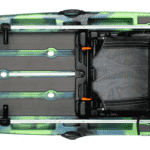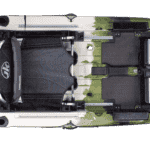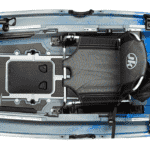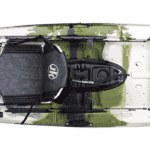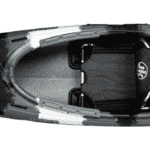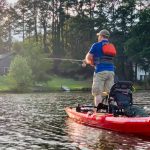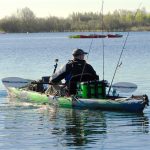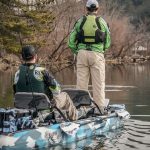Jackson YuPIK is all about customizability. With an open-concept deck and tons of gear tracks all over, this kayak is a blank slate waiting for you to make it yours.

Jackson Coosa is a well thought out kayak for fast-moving rivers, shifty creeks, tight waterways, but also for ponds and small lakes. It is a versatile fishing boat co-designed with the professional kayak angler Drew Gregory and named after the Coosa river.
As an affiliate of Amazon and other retailers, we may earn a small commission when you buy via our links, at no additional cost to you. Thank you!
|
RELATED: Jackson Kayaks: Full Model Lineup and Reviews
Pros:
- Maneuverability
- Lots of underdeck storage
- Open standing space
- Tracks well
- Multiple rod parks
- Lockable hatches
- Drag chain/anchor recess
Cons:
- No gear tracks
- Limited gear mounting options
Size and Weight
Jackson Coosa is 11’2” long and 32″ wide. It weighs 65 lbs without the seat and 70 lbs with the seat. One person can handle and transport it easily. Better yet, a replaceable skid plate lets you drag the kayak to and from the water.
Capacity
The Coosa has a total capacity of 350 lbs and is best suited for average-sized anglers who don’t take too much gear with them. However, we’ve seen reports from people that are 6’2″ tall and weigh 270 lbs but still enjoy the boat.
In any case, for a drier ride and better performance, it’s best to stay within 80 percent of the boat’s maximum capacity. That includes your own weight plus all of your clothes and all of the gear you take along.
Construction and Material
Jackson’s Coosa is one of the new “superlinear” PE kayaks. It is made from High-Density Polyethylene using the rotational molding technology. Beads of polyethylene are poured into the mold; the mold is heated up and slowly rotated so that the material fills up every nook and cranny. After the mold cools down, you get a one-piece construction that is extremely rugged and durable.
Jackson Kayak is known for its high-quality materials. Their kayaks last a very long time.
The downside of polyethylene is that it is a very non-stick material. If you manage to put a hole in the hull, you can’t just glue a patch to it. Repairing requires a piece of the same material and a blowtorch to melt it onto the hole.
Hull Design
The Coosa’s rockered streamlined hull was specifically designed for fly fishing enthusiasts enabling stability in rapids when loaded with gear. The boat slides a few rocks just to get you to the fishing spot not many other 32″ wide kayaks can.
The versatility of the Coosa’s hull design is its adaptability to different waters. It can serve your fishing hobby in sheltered waters like small lakes and ponds, it can take you through the marches and allow safe adventures in whitewater up to class IV, provided there’s no wind. The blunt bow tip suggests that the boat isn’t very fast in calm waterways, but that’s not what it is intended for, either. The thing we can state for a fact is that the Coosa tracks, stays buoyant and empowers fishing.
Deck/Cockpit
The Coosa’s 23.5″ open deck is clean, free from consoles, excessive accessories and gadgets. It offers an ideal surface for free movement and fly fishing. The anti-slip pads are pretty weather-resistant and dampen the sounds that could potentially spook the fish. The whole boat is a silent predator. Another interesting idea is the molded ribs under the footrest rails. They are meant to support your feet when you are not using the pegs. The ribs provide stability and push off while paddling.
The risk of entangled lines is practically non-existent due to the molded-in rod stagers – three on the bow hatch lid, two in the cockpit, and one on each side of the boat.
The bungees that secure the hatches and the tank well are simply bolted down without the use of hooks to avoid intertwining lines. A total of six scupper holes are located in the cockpit to provide better stability in that part of the kayak. The draining plug and chutes are at the stern. This is a smooth, streamlined boat that offers a relaxed fishing activity for days. The Coosa comes with a stand-assist strap to help you get up safely and easily if you still haven’t found the boat’s balance.
Seat
The Coosa comes with a very comfortable Ergo Seat. Its robust metal frame is covered with quick-dry seat padding and backrest. The heavy-duty straps adjust the sitting firmness and the back support angle.
The ergonomic seat can be set to high and low sitting positions by slightly loosening the safety strap under the chair and push the frame into the desired molded slot.
The seat is foldable and completely removable, doubling as a cushioned camping chair with extra lumbar support suitable not only for heavy paddling but also for unwinding.
The Coosa’s seat is designed to be durable, practical, and comfortable. The low-sitting position helps you become part of the kayak while surfing the whitewater, during intense paddling the fast-current twists and living the adventure.
When the chair is changed to a high sitting position, you have a wide, clear view of the water. This position is great for sight fishing for redfish or bass.
Storage
With the Coosa, this is a subject we can talk about for a long time. Unlike other kayaks of this size that mainly offer one or two dry hatches, this boat offers three with some serious innovations that started from its original model. Both the bow and stern hatches are of trapezoid shape and are hinged. Their openings are lifted in the form of a molded ring under the lid, which is sealed with a gasket, thus blocking the water from entering the compartment.
In the bow hatch, with its dimensions of 8.5″x11″x15.5″ you can store rods up to 11′ long because it is connected to the rear hatch and is secured with bungees. Alternatively, you can stow a tent, a cooler, rain gear, or a small stove inside the hull itself.
In the cockpit, the Jackson Coosa provides a 5.5″ easy-access day hatch where you can safely keep your cell phone, keys, or other personal belongings. This hatch has a rubber lid that tightly seals the opening and keeps your things dry inside.
Under the seat, when it is set to the high position, there are two molded sections where you can keep up to four tackle boxes of a standard size and have them at hand while fishing.
The rear hatch of 8.5″x5″x8.5″ is secured with a rotating latch that easily stores 10-liter bags or boxes. The compartments’ advantage is not only in their size but also in the opening shape because unlike the oval ones, here you can comfortably put a square or rectangular hard plastic boxes or coolers together with your fishing gear and personal equipment needed to have a great day outdoors.
Another unique advantage they have is the ability to lock both hatches with a small padlock in case you need to make a quick stop on the road.
None of the hatches have cargo bags inside, but since each is conveniently located in the front, middle and rear of the kayak and the underdeck storage space is connected, you have good access to the entire in-hull space.
Gear Mounts
This is probably the one weak point that has been left out from the Coosa. There are four RAM mount inserts that come with the kayak. Two are located on each side of the tank well, between the bungees, whereas the third and fourth are in the cockpit deck. You can use the inserts to mount a fish finder (there’s lots of underdeck space for the transducer battery and wiring) or additional rod holders in the rear.
There’s also a GoPro mount on the front deck. That’s pretty much it with pre-installed gear mounts.
The one and only complaint Coosa owners have is putting gear tracks on the tank well gunnels with adjustable sliding lockdowns with bungees so you can mount rod holders or other gear wherever you need it, not on those two specific places.
The great thing about this boat is that it comes with molded-in rear chutes for drag chain or anchor system. It is a fairly quick and straightforward process to install an anchor trolley or a drag chain on the Coosa.
However, we would like to point out that the lack of gear mounts on this particular boat is intentional and comes with the design. Not having so much gear means there are fewer things for your lines to snag on. Its fans enjoy this kayak for this very reason. Very few of them mount any gear other than a fishfinder, a couple of rod holders, top-load gear tracks, and a drag chain or anchor.
Rod Holders
Jackson Coosa comes with two flush-mount rod holders behind the seat. These are designed for casting rods and can be shallow for spinning or fly fishing poles. Kudos to Jackson Kayaks for angling the rod holders downwards, to the sides, allowing you to fish in areas with low branches hanging over the river without worrying about hitting the trees or tangling the lines.
With the Coosa, you can park fishing rods anywhere you want. The front hatch comes with three molded rod stagers that allow you to rest the rods while needing to switch lures or simply take out the fish that bit the bait. There are two grooves next to the chair where you put the rod butt and lay the rod onto the stager. These sideways rod stagers are not extended enough to park 7-foot or longer rods. Many people moved the bungees more towards the back of the boat and solved the problem.
Additionally, in front of the chair, you can put away your paddle onto the stagers enabling you to focus on fishing, perhaps even wade fishing.
Footrests
The Coosa uses a reliable and sturdy set of footrests, which you can adjust to the most comfortable sitting position regardless of your height. The footrests slide on a fore and aft onto a rail with multiple breaks that position the peg.
Paddle Holders
The Coosa offers several positions to rest your paddle while being busy fishing. One of the most common solutions is the bungee secured paddle holders on each side of the boat, right beside the seat. You can also use the molded paddle stager right behind the footrest rails. The Coosa doesn’t come with a paddle park on the front hatch.
Handles
The Coosa has four flush-mounted ergonomic handles. The two on the bow and stern are rigid and made from hard plastic. The two on the sides are a bit softer and allow more cushioned grip. Some kayakers replace the sideways handles and buy the same as the front and rear, while others are satisfied with the standard handles. Both kinds are reliable for carrying the kayak and can be used for tying down the boat for safe transportation.
Stability
The Coosa’s 32-inch beam with a 23.5-inch open standing deck and good weight distribution ensure excellent stability for any trip. Once you get used to the kayak and find your balance, you realize how stable the Coosa really is. However, it can feel wobbly, even tippy, in a strong wind.
Maneuverability and Tracking
This is a kayak that with excellent maneuverability. The smooth edges and rockered hull expand the boat’s ability to handle choppy waters, fast currents, and sharp turns.
The Coosa is a very agile kayak. With a length of 11’2″ it can easily navigate fast rivers and creeks providing straight and smooth tracking.
On flat water such as ponds, lakes, or slow rivers, the Coosa combines good maneuverability and straight tracking.
The only maneuverability and tracking issues can happen on open waters and big lakes on a windy day. The Coosa can handle any water as long as there’s light or no wind.
Speed
The Coosa is rather wide-beamed for an 11-foot kayak and is designed to skim fast-flowing rivers floating with only several inches in the water. It develops great speed and allows you to surf areas where not many fishing kayaks can enter. It can be fast in sheltered lakes or ponds, but in order to achieve better speed, you need to paddle. It does maintain the speed for a short time, but the width slows it down.
Care and Maintenance
Rotomolded kayaks are incredibly durable and require minimum maintenance. However, to make sure that the kayak always performs well when plunged into the water, we must follow some general rules:
Regardless of how uneventful the paddling has been, upon arrival home, always check the hull for cracks, abrasions, or more serious breaches. Light nicks and scratches are a normal part of the experience. It is also a great time to get the new gear you were dreaming of last year.
During the season, it is a good idea to quickly spray down your kayak after each trip (especially in saltwater). Store the kayak away from direct sunlight or use kayak covers. Avoid dragging the kayak on its hull if possible. A kayak cart is a great and inexpensive accessory that can prolong the life of your boat.
Make sure you get any sand, dirt, or dead bugs out. Check the rigging and see what needs replacement. Loosen any bungees or straps that can be loosened. Apply some corrosion protection (like WD-40) to metal joints, screws, and bolts.
Always check the straps, buckles, hatch cover, and cords if they hold a strong elasticity. If any of the moving parts become loose, it is better to replace them.
Storage
Dry the boat thoroughly. Store your kayak on its side, never on the hull, and to protect your boat, provide shelter from the sun. To prevent heat build-up, do not cover the boat with tarp laying directly on its surface.
Leave adequate air space to allow for air circulation. If possible, it is best to store your kayak inside for the winter. Don’t allow water to accumulate between the deck and hull and freeze.
About the Manufacturer
Jackson Kayaks was founded in 2003 by world champion and Olympic kayaker Eric Jackson, design partner David Knight and friend, Tony Lunt. Based near Rock Island, Tennessee, Jackson Kayak is well-known both in the kayak fishing world and among freestyle kayaking athletes. In fact, many of the world’s leading freestyle kayakers use Jackson kayaks.
Warranty
For kayaks bought in 2019 and earlier, Jackson offers a 3-year limited warranty. For kayaks bought in 2020, the warranty period has been increased to 5 years.
The warranty covers substantial defects in materials and workmanship in the hull and outfitting components made by Jackson Kayak.
The warranty applies from the original date of purchase from an authorized dealer. For demo boats and used boats, the warranty begins from the date the kayak was shipped from Jackson. Unlike with some other manufacturers, Jackson’s warranty also applies to subsequent owners of the kayaks, not just the original owner.
Depending on the year of the warranty period, Jackson will repair or replace the hull and/or outfitting components, as follows:
Watercraft Purchased 2020 and After
First Year of Warranty: We’ll replace or repair the hull for free (or we’ll replace the complete boat for 10% of the current MSRP), Free Shipping
Second Year of Warranty: We’ll replace or repair the hull for 10% of current boat MSRP (or we’ll replace the complete boat for 30% of the current boat MSRP), plus shipping.
Third, Fourth and Fifth Year of Warranty: We’ll replace or repair the hull for 30% of the current boat MSRP (or we’ll replace the complete boat for 50% of the current boat MSRP), plus shipping.
Note that some components are manufactured by independent companies and are covered by separate warranties. You can learn more by contacting Jackson.
To submit a warranty claim, you will need proof of purchase. Jackson may require you to provide photos of the damage or to return the product at your own cost.
International warranty claims are handled via Jackson’s distributors. Warranty terms may be different in different countries. Please contact your local dealer to learn more.
For full Jackson’s warranty terms, click here: https://www.jacksonadventures.com/warranty/
|






